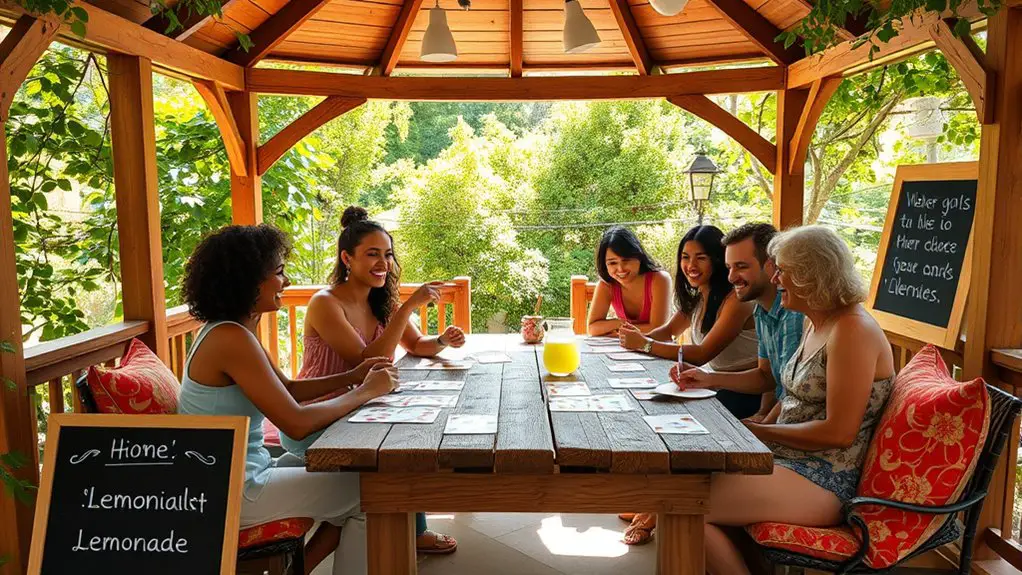Your gazebo is a perfect space for communication and collaboration games. Start by arranging seating in a circle to enhance interaction. Kick things off with icebreaker games like name games and laughter exercises to create a friendly atmosphere. Next, plunge into team-building activities like the “Marshmallow Challenge” that fosters problem-solving and trust. Don’t forget to incorporate communication challenges to sharpen skills. If you’re curious about wrapping it all up effectively, there’s more to explore!
Setting the Stage: Preparing Your Gazebo for Games
Before you plunge into the fun of games, it’s essential to create the perfect atmosphere in your gazebo. Start by considering the gazebo layout; think about how the space can enhance interaction. Arrange your seating in a circle or semi-circle to foster connection and encourage everyone to participate. If you have a larger group, consider grouping chairs in clusters to promote small discussions.
Next, think about comfort. Add cushions or blankets to your seating arrangements for a cozy vibe, making it easy for everyone to relax and enjoy.
Don’t forget about lighting! String lights or lanterns can create a warm, inviting ambiance as the sun sets, making your gazebo an ideal setting for games. Additionally, ensure that your gazebo is weather resistant to provide reliable shelter during unexpected changes in weather conditions.
Icebreaker Games to Kick Off the Fun
Now that your gazebo is set up for comfort and connection, it’s time to break the ice and get everyone warmed up for a good time. Icebreaker games are perfect for creating an atmosphere of fun and openness. Start with some name games; they not only help people remember each other but also set a friendly tone. Try a simple round where everyone shares their name and an interesting fact about themselves.
Next, incorporate laughter exercises to lighten the mood. Have everyone stand in a circle and take turns making silly sounds or movements. This encourages laughter and builds camaraderie.
Team-Building Activities to Foster Collaboration
While icebreakers set the stage for fun, team-building activities take the experience to a whole new level by fostering collaboration and strengthening relationships. In your gazebo, try activities like the “Marshmallow Challenge.” Teams compete to build the tallest structure using only spaghetti, tape, and a marshmallow. This exercise promotes problem solving and trust building as members must rely on each other’s strengths.
Another great option is a “Team Quiz,” where groups answer questions about each other. It encourages communication and deepens connections. For a more active twist, consider a scavenger hunt. Participants work together to find items around your gazebo, enhancing teamwork and camaraderie. Additionally, incorporating design elements into your gazebo can make these activities even more engaging and enjoyable for everyone involved.
Communication Challenges to Enhance Skills
To boost communication skills in a fun and interactive way, consider incorporating challenges that push participants out of their comfort zones. These activities can enhance active listening and help everyone become more aware of nonverbal cues. Here are three engaging challenges you can try:
Boost communication skills with fun challenges that enhance active listening and nonverbal awareness among participants.
- Silent Conversations: Pair participants and have them communicate only through gestures for a few minutes. This encourages awareness of nonverbal cues and promotes creativity in expression.
- Story Building: In a circle, each person adds a sentence to a story. This requires active listening to guarantee the narrative flows and stays coherent.
- Blindfolded Partner Walk: One partner is blindfolded while the other gives directions. This builds trust and highlights the importance of clear communication and active listening.
Creative Wrap-Up: Reflecting on the Experience
As you wrap up your games in the gazebo, taking a moment to reflect on the experiences can deepen the learning and enjoyment for everyone involved. Organizing a feedback session is a great way to encourage open dialogue. Invite participants to share their thoughts on what they enjoyed and what they found challenging. This not only fosters a sense of community but also allows everyone to voice their perspectives.
After gathering feedback, facilitate a group reflection. Ask questions like, “What did you learn about communication?” or “How can we collaborate more effectively next time?” This encourages critical thinking and reinforces the skills practiced during the games.
Wrap up by celebrating achievements, big or small. Remind everyone that each game is a stepping stone toward growth. By nurturing this reflective practice, you’re not just playing games—you’re building a foundation for freedom and creativity in communication.
Frequently Asked Questions
What Types of Seating Arrangements Work Best in a Gazebo?
When considering seating arrangements in your gazebo, circle seating encourages interaction and connection, while bench seating maximizes space. Both options promote a relaxed atmosphere, allowing everyone to engage freely and comfortably during gatherings.
How Can I Ensure Everyone Participates in the Games?
To guarantee everyone participates, employ engagement strategies like icebreaker activities. Create a relaxed atmosphere where everyone feels comfortable sharing. Encourage teamwork and emphasize the fun aspect, allowing each person to contribute in their unique way.
Are There Specific Weather Considerations for Outdoor Games?
When planning outdoor games, consider sun protection with hats and sunscreen, and have a rain contingency ready, like tarps or a backup indoor space. Flexibility’s key to keeping everyone comfortable and engaged, rain or shine!
Can These Games Be Adapted for Virtual Participants?
You might think outdoor games can’t include virtual participants, but they can! By using virtual engagement strategies and remote collaboration tools, you can create an inclusive experience that keeps everyone connected, no matter where they are.
What Age Groups Are Suitable for These Communication Games?
These communication games work well for various age groups. Children’s activities can be tailored for younger audiences, while adult teamwork games foster collaboration among older participants. Everyone can enjoy engaging, interactive experiences that encourage creativity and connection.

